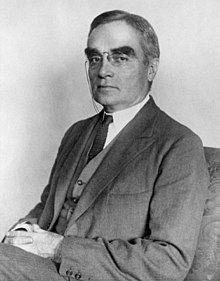United States v. Carroll Towing Co.
United States v. Carroll Towing Co., 159 F.2d 169 ( 2d. Cir. 1947), is a decision of the 2nd Circuit Court of Appeals by the Judge Learned Hand . Learned Hand laid down the economic negligence concept in it based on the torts (' civil law offense ') negligence ('negligence').
facts
On January 4, 1944, the Anna C sank in New York Harbor . The United States had rented this barge. The barge was carrying flour. The United States sued for damages for the flour.
The owner of the barge was the Conners Marine Company. From this the Pennsylvania Railroad Company had chartered the barge. The Anna C was moored at Pier 52 on the North River . The ships at Pier 52 were connected to one another by ropes, one of them also at the Public Pier. The Carroll tug was supposed to take one of the ships off the public pier . One of the ropes between the ships at Pier 52 and the Public Pier was cut. As a result, these ships floated loosely. The Anna C sank.
The Anna C could have been saved: Both the tug Grace (owned by Grace Line ) and the tug Carroll had the necessary devices. Due to the skipper's absence, however, no one noticed her impending sinking in time.
judgment
The judgment was an appeal against a decision of the District Court of the United States for the Eastern District of New York . Judge Learned Hand first stated that there was no general rule of common law to determine when an absent skipper would hold the owner of the ship liable for damage to other ships. However, he suggested a general formula as a measure of liability:
“Since there are occasions when every vessel will break from her moorings, and since, if she does, she becomes a menace to those about her; the owner's duty, as in other similar situations, to provide against resulting injuries is a function of three variables: (1) The probability that she will break away; (2) the gravity of the resulting injury, if she does; (3) the burden of adequate precautions. Possibly it serves to bring this notion into relief to state it in algebraic terms: if the probability be called P; the injury, L; and the burden, B; liability depends upon whether B is less than L multiplied by P: ie, whether B <PL. "
Put simply, the test says: There is no negligence if the costs of preventing damage from occurring are greater than the probability of damage occurring times the amount of damage.
The court referred the case back to the lower court for a new decision on this basis.
